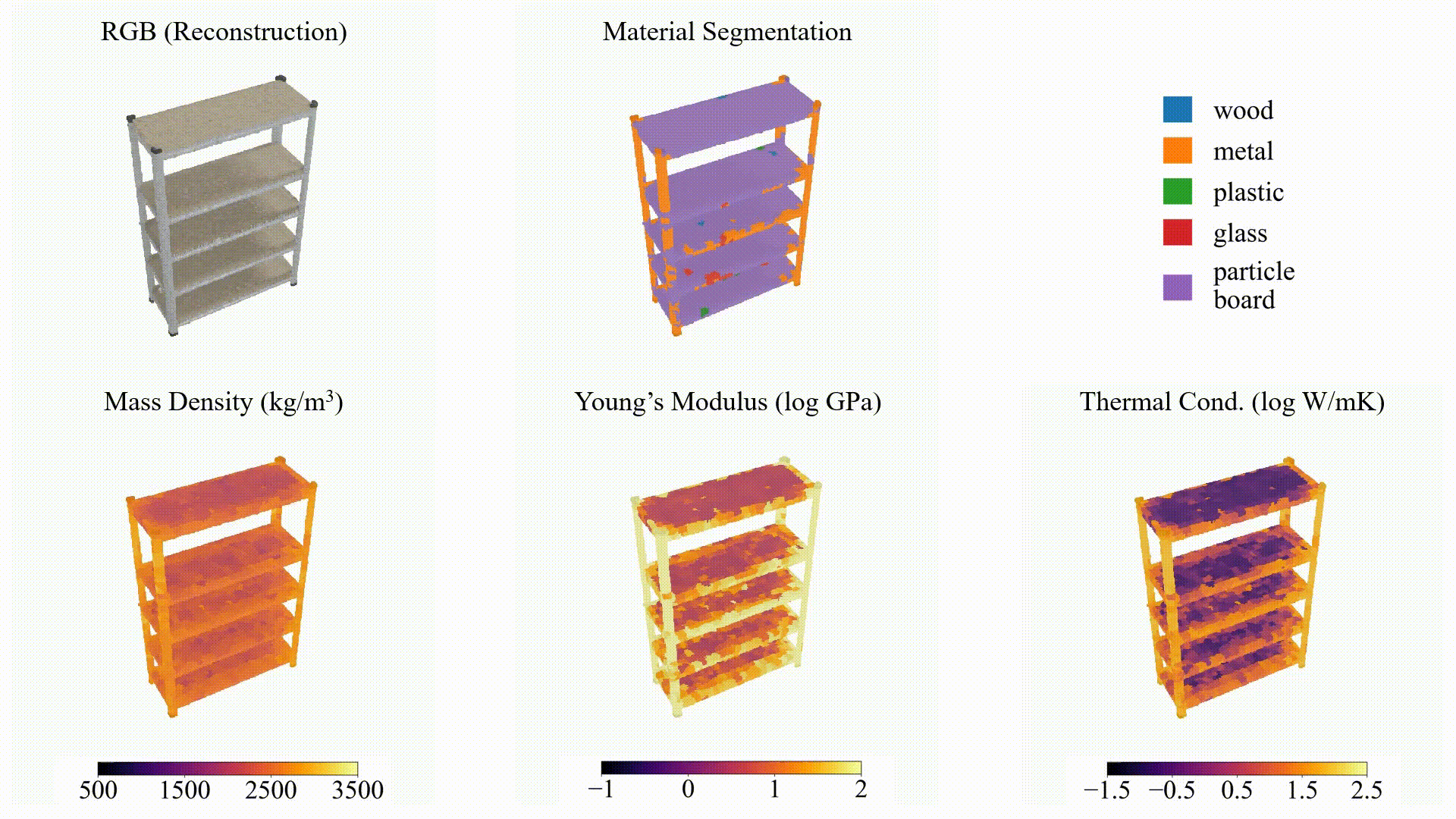Albert J. Zhai, Yuan Shen, Emily Y. Chen, Gloria X. Wang, Xinlei Wang, Sheng Wang, Kaiyu Guan, Shenlong Wang
University of Illinois at Urbana-Champaign
CVPR 2024
Infer physical properties densely in 3D for any object!

Our method involves 3D reconstruction using Nerfstudio. If you want to modify the reconstruction or reproduce it on your own data, you will need to follow the official instructions to install Nerfstudio.
Besides the initial reconstruction, the rest of our method operates on the extracted depth maps/point cloud (which we provide in our dataset) and thus does not require Nerfstudio. So if you don't wish to run Nerfstudio, the only things you need to do are 1) install PyTorch, and 2) run
pip install -r requirements.txt
to install the remaining dependencies.
Our method uses BLIP-2-Flan-T5-XL for image captioning. To download the model weights, clone the repository into the root directory of this repository (you will need Git LFS). You can also download it elsewhere and specify the location via the --blip2_model_dir argument.
Our method involves calling GPT via the OpenAI API. This requires having an account with some credits on it (usage will be fairly minimal). Once you have an account, find your API key here and set a variable named OPENAI_API_KEY to your key in a Python file named my_api_key.py. Example (replace <yourkey> with your API key):
echo "OPENAI_API_KEY = '<yourkey>'" >> ./my_api_key.py
We provide ABO-500, a dataset of multi-view images of objects from Amazon Berkeley Objects (ABO) with camera parameters and ground-truth object weights. We also provide the intermediate outputs from our method so that you can run any part of our method without needing to run the previous parts. Please download the dataset via this Box link
and unzip into a directory data/ (you can also put it elsewhere and specify --data_dir later).
Example with curl:
curl -L https://uofi.box.com/shared/static/743ydh4n1xi0dj05lcyyg4evqk2n4dko.zip \
--output ./abo_500.zip
unzip ./abo_500.zip -d ./data/
Overview of our method:
 We provide separate Python scripts for running each component in our method. Command-line arguments for all of the scripts can be found in
We provide separate Python scripts for running each component in our method. Command-line arguments for all of the scripts can be found in arguments.py. Intermediate outputs get stored in the scene data directories. If you are using our provided dataset, you can start from anywhere along the pipeline without running the previous components.
We use Nerfstudio to train NeRFs and extract depth maps and point clouds. We have wrapped all of the Nerfstudio commands into ns_reconstruction.py. Example (only processes one scene):
python ns_reconstruction.py --end_idx 1
This is the only step that requires Nerfstudio.
Feature fusion is done in feature_fusion.py. Example (only processes one scene):
python feature_fusion.py --end_idx 1
Captioning and view selection are both done in captioning.py. Example (only processes one scene):
python captioning.py --end_idx 1
This requires downloading the BLIP-2 model (see Requirements above).
Material proposal is done in material_proposal.py. You can specify the physical property of interest using the --property_name argument. Currently, only mass density, friction, and Shore hardness are supported, but feel free to make prompts for other properties (see gpt_inference.py). Example (only processes one scene):
python material_proposal.py --property_name density --end_idx 1
This requires setting your OpenAI API Key (see Requirements above).
Physical properties are predicted using CLIP-based kernel regression in predict_property.py. Example (only processes one scene):
python material_proposal.py --property_name density --end_idx 1
By default, the script will predict a volume integral of the physical property (e.g. predicting mass by integrating density). You can instead get dense results for a 3D grid of points by setting --prediction_mode to grid. You can also write your own code using the predict_physical_property_query function to query points however you want.
We provide a script for quantitative evaluation of mass predictions in evaluation.py. The results will be printed in your terminal. Example:
python evaluation.py
Explanations of each metric can be found in our paper.
We provide a script for interactively viewing and saving 3D visualizations in visualization.py. You should specify the scene name using the --scene_name argument. Example:
python visualization.py --scene_name B075YQXRBS_ATVPDKIKX0DER
To run our method on your own data, you can use Nerfstudio's data processing tool to convert your data into the right format. You can then run the components of our method in order.
Please cite our paper if you find this repo useful!
@inproceedings{zhai2024physical,
title={Physical Property Understanding from Language-Embedded Feature Fields},
author={Zhai, Albert J and Shen, Yuan and Chen, Emily Y and Wang, Gloria X and Wang, Xinlei and Wang, Sheng and Guan, Kaiyu and Wang, Shenlong},
booktitle={CVPR},
year={2024}
}